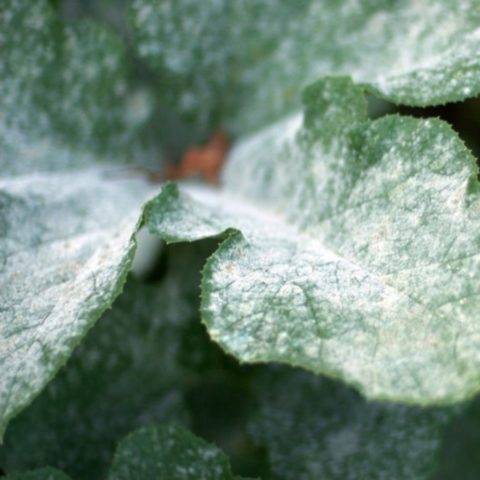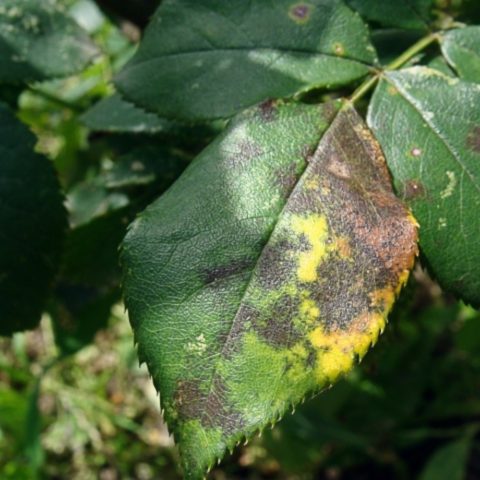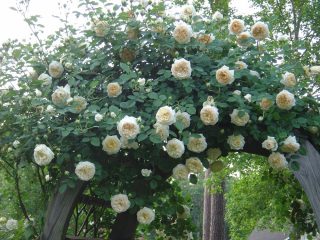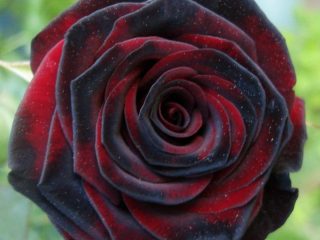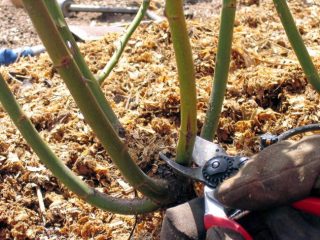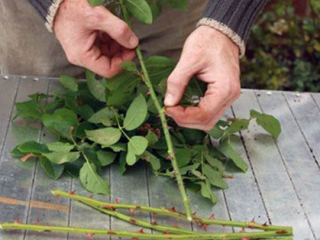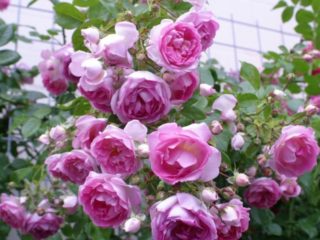Content
- 1 History of selection
- 2 Description and characteristics of the ground cover rose Svani
- 3 Advantages and disadvantages of the variety
- 4 Varieties of Svani roses
- 5 Reproduction methods
- 6 Growing and care
- 7 Pests and diseases
- 8 Application in landscape design
- 9 Conclusion
- 10 Reviews of the ground cover park rose Svani
Along with tall varieties of roses, varieties with creeping shoots, which are characterized by long and abundant flowering, are also widely used in landscape design. Their use allows you to give any composition a sense of sophistication. Therefore, they have become an indispensable element for the most daring design solutions. One of these types of crops is the ground cover rose Svani or Swani, as it is sometimes called. It has the ability to grow quickly and cover large areas of the flower bed, filling the free space.

Ground cover rose Svani does not require the formation of a bush
History of selection
The ground cover rose Swany was bred in France in 1978. Its originator is the Meilland company. The founder of the nursery, Maria Louise Mailland, worked on the creation of this variety.
The basis for Svani was two evergreen roses: Rosa sempervirens and Rosa wichurana. The resulting variety was able to take only the best qualities from its ancestors.Thanks to this, Svani has become one of the most popular ground cover crop varieties.
Initially, this variety was given the intermediate name “MEIburena”, but already at the first exhibition it was presented under its current name. Since then, Svani has become the standard of ground cover roses, since in its characteristics and decorativeness it significantly surpassed all species known at that time.
Description and characteristics of the ground cover rose Svani
This variety is considered one of the most popular among ground cover roses, and this is no coincidence. The plant remains decorative throughout the season and does not require complex care.
The ground cover rose Svani is a lush bush with numerous creeping shoots. The height of the plant reaches 50-60 cm, and the diameter varies from 1.50 to 2.0 m, depending on the growing conditions. The shrub forms long thin shoots that bend well, but cannot be broken. They are densely leafy. The bark of young shoots of the Swaney rose is bright green, but as they age it becomes dull and acquires a brownish-gray tint. Along the entire length of the branches there are small thorns in the form of a rounded hook.
Young leaves are light green, but later they become darker and acquire a beautiful shine. This significantly improves the decorative appearance of the shrub. The leaves are alternate. They consist of 5-7 oblong-oval plates, which are attached to one common petiole. The length of each segment does not exceed 2.0-2.5 cm, and the width barely reaches 1.5 cm.The surface is smooth on both sides.
Rose Svani blooms continuously throughout the season. This is achieved through the constant growth of new shoots, on the tops of which buds are formed. The beginning of this period occurs at the end of May or the first ten days of June, depending on the growing region. The flowers of this ground cover rose are quite large for this species. Their diameter when fully expanded reaches 5-6 cm.
The shrub forms numerous rounded-pointed buds, which are collected in umbrella inflorescences on long stems. Each of them consists of 5-14 pieces, and in adult bushes their number can reach up to 20. The flowers consist of graceful, slightly curved petals. They are pure white, but the center of the flower may have a soft pink color.
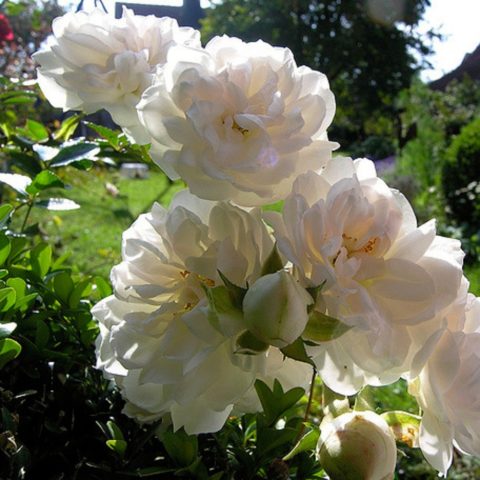
The flowers of the Svani rose are densely double, consisting of 40-50 petals
The aroma of this variety is pleasant, floral, but weakly expressed. The smell intensifies slightly only during the midday and evening hours.
The root system is mostly concentrated in the upper layers of the soil. It is branched and located horizontally to the ground surface.
The ground cover rose Swaney white has an average level of frost resistance. The shrub can withstand temperatures ranging from -12 to -20 degrees. Since most of its inflorescences are formed on last year’s shoots, the plant requires obligatory shelter for the winter. This is not difficult to do, since the ground cover rose Svani forms low bushes.
This variety of crop, under favorable conditions, practically does not suffer from fungal diseases.But in case of prolonged rains and cool weather, the plant’s immunity decreases. To avoid this, preventive spraying of the bush with fungicides should be carried out.
Advantages and disadvantages of the variety
According to the description, photos and reviews from gardeners, the ground cover rose Svani is distinguished by its high decorative qualities and low maintenance requirements, which sets it apart from other varieties. But, like other types, it has not only advantages, but also some disadvantages. Therefore, when choosing, you need to pay attention to them so that this does not later become an unpleasant surprise.
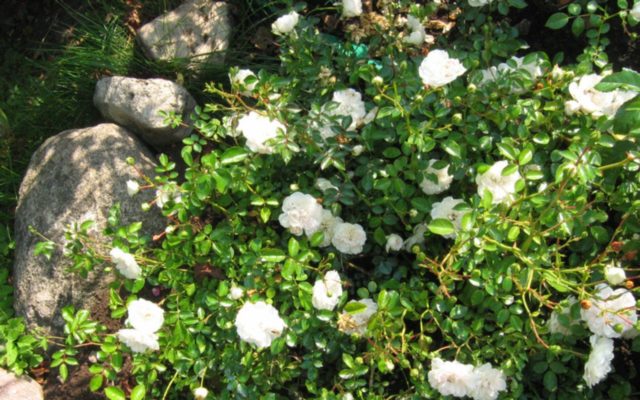
The flowers of the ground cover Svani have the shape of a rosette
Main advantages:
- long, abundant flowering;
- versatility of use in landscape design;
- low maintenance;
- good winter hardiness;
- resistance to fungal diseases;
- high decorative qualities;
- large diameter flowers;
- suitable for cutting;
- easy to reproduce;
- quickly recovers in case of freezing.
Flaws:
- the bush does not have the ability to self-clean;
- faint aroma of flowers;
- during prolonged rains, the decorative value of roses decreases;
- requires shelter for the winter.
Varieties of Svani roses
The high popularity of the ground cover rose Svani inspired its originator to create other species based on this variety. They all have common characteristics, but there are also obvious differences. Therefore, you should familiarize yourself with the popular subspecies of Svani to avoid confusion.
Swany Mimi
The variety was developed in 2001 and was initially given the technical name MEIshasen. Rose Svani Mimi is distinguished by medium-sized bushes, the shoots of which have practically no thorns. Initially, the buds are pink, but when they bloom, the outer petals become light, and the bright color remains only in the center. This gives the variety a special tenderness and sophistication. The diameter of the flowers of this rose is no more than 3 cm. But the bush produces a huge number of them, so during flowering the foliage is practically invisible.
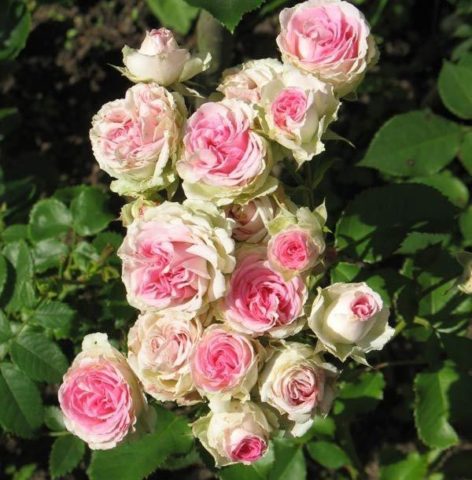
In many catalogs, the rose Svani Mimi is listed as Mimi Eden
Super Swany
The variety was bred in 1987. Super Svani forms spreading bushes, the height of which in rare cases reaches 1.4 m. The flowers of this variety are densely double, almost white, but a soft pinkish tint is allowed along the edge of the petals. Their diameter is about 5-6 cm.
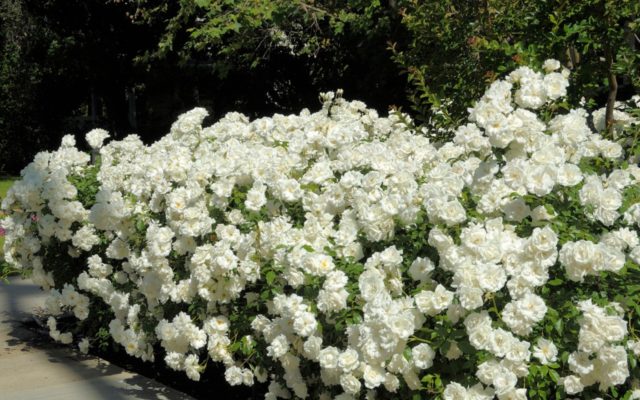
Rose Super Swaney has no scent
Pink Swany
This variety of ground cover rose was obtained in 2003 and is intended specifically for group plantings. Pink Swany's flowers are densely double and even when fully opened, their center is not exposed. The height of the bush reaches 60-80 cm, and the diameter is about 110 cm. But since each Pink Swaney rose flower has 90-100 petals, visually the plant seems much larger than its size. The flowers are pink with a slight purple tint. Their diameter is 7-8 cm.

The color of the ground cover rose Peak Svani is bright in the spring, but fades by autumn
Rose Red Swany
This variety of ground cover rose is distinguished by spreading bushes, up to 2.0 m in diameter and about 60 cm in height. Red Swaney flowers are bright red in color with a pleasant, delicate aroma. The variety is also characterized by openwork petals.The flowering period is long, it begins in early summer and lasts until autumn frosts.
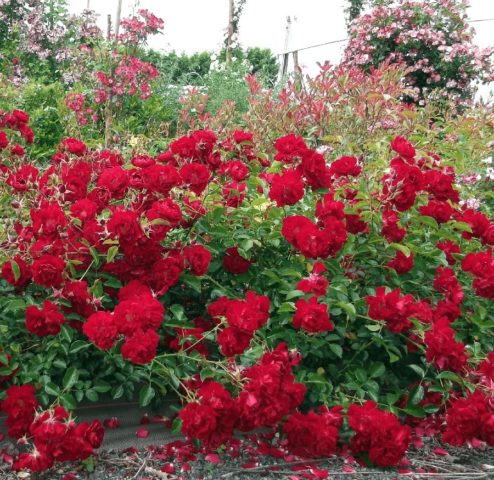
Ground cover rose Red Swaney does not require formative pruning
Reproduction methods
This variety is easily propagated by layering and cuttings. The first method is quite simple and can be used even by a gardener who does not have much experience. To do this, it is enough to deepen several shoots 5-10 cm into the soil, leaving only the top on top and keeping the soil constantly slightly moist throughout the season. You can separate the cuttings from the mother bush the next year.
The cutting method is more complex, but makes it possible to obtain a large number of seedlings. To do this, before flowering, it is necessary to cut the lignified shoots into pieces 10 cm long with 2-3 internodes. The lower leaves should be completely removed, and the upper leaves should be left for sap flow. After this, powder the cut with any root former and plant the cuttings in the ground. To create optimal conditions, it is necessary to cover them with transparent caps. Young seedlings can be transplanted to a permanent place only at the age of 2 years.
Growing and care
The ground cover rose Svani can be planted in open ground in the spring in the central and northern regions, and also in the fall in the southern regions. For this variety, you should choose sunny and slightly shaded areas with fertile soil and good aeration.

This variety should not be planted in the shade, otherwise there will be no abundant flowering.
2 weeks before the procedure, you need to prepare a planting hole measuring 50 by 50 cm. Place a 7-10 cm layer of drainage on the bottom, and pour an equal volume of soil mixture of turf, sand, humus and peat on top. When planting, the root collar of the seedling must be deepened by 2 cm.
When growing this variety, you must adhere to standard care rules. They consist of timely watering in the absence of seasonal rains. For this you need to use settled water at a temperature of +18-+20 degrees. Irrigation should be carried out in the evening to prevent foliage burns.
Also, the ground cover rose Svani needs feeding. Therefore, in the spring, at the beginning of the growing season, it needs to be fertilized with nitroammophos (30 g per 10 l) or fermented chicken manure (1:15). In the future, phosphorus-potassium mineral mixtures should be used, which will increase the number of buds, prolong flowering and increase the frost resistance of the shrub. The frequency of their use is once a month.
To prevent weeds from growing under the shoots of the Svani rose, it is necessary to lay a layer of tree bark 3 cm thick. Such mulch will not only help reduce watering, but will also prevent overheating of the roots in the heat, and will also provide the required acidity level of about 6.0-6.5 pH .
The ground cover rose Svani does not need to form a bush. Therefore, every year in the spring it is necessary to remove only damaged and frozen shoots, which reduce the decorative effect. For the winter, this shrub requires shelter. To do this, you should initially cover the root system with a thick layer of soil and compact it. And then protect the rose completely with agrofibre.
Pests and diseases
This variety exhibits resistance to diseases and pests.But if the growing conditions are inappropriate, as well as in the absence of proper care, the immunity of the Svani rose decreases.
Possible problems:
- Powdery mildew. The disease manifests itself as a white coating on the leaves, which then becomes dirty gray. This interferes with photosynthesis and causes the plates to wither. Topaz should be used for treatment.
- Black spot. The disease progresses with sudden changes in day and night temperatures. Initially, black dots appear on the leaves, and then they grow to spots. As a result, premature leaf fall occurs, and the shoots are completely exposed. For treatment and prevention, “Skor” should be used.
- Aphid. A small pest that is localized on young leaves and shoot tips. It feeds on rose juice. With massive damage, the buds become deformed and the bush stops blooming. To fight, you should use Confidor Extra.
- Spider mite. A microscopic pest that cannot be seen with the naked eye. The lesion can be recognized by the dull shade of the leaves, slow growth, deformed buds and small cobwebs on the tops of the branches. To destroy, you should use Actellik.
Application in landscape design
The ground cover rose Svani is widely used in landscape design. Its creeping shoots can successfully disguise all unsightly surfaces. Therefore, shrubs are often planted on slopes and near high borders. This variety is also ideal for alpine slides, the foreground of flower beds and landscaping the entrance to the gazebo.
You can also find the standard rose Svani on sale, as its flowing shoots at a height look very elegant, creating the impression of a flower fountain.
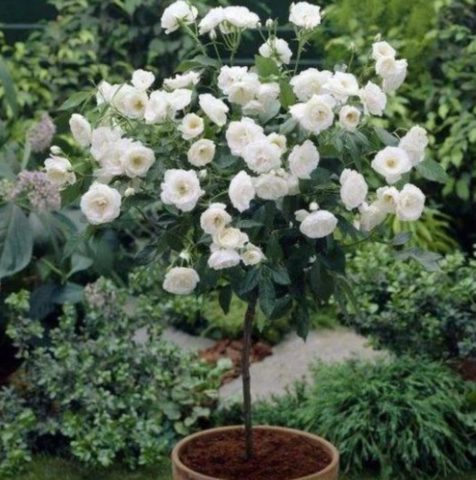
This variety can also be grown in tubs to decorate balconies, terraces, and stairs.
Conclusion
Ground cover rose Svani is a highly decorative type of crop that enjoys well-deserved popularity among gardeners all over the world. And the ability of this shrub to fit into any landscape design only contributes to this. It is important to remember that the plant must be completely covered for the winter in order to preserve the shoots that will bloom next season.
